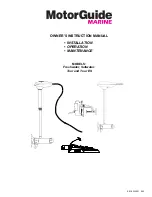
AD9361 Reference Manual
UG-570
| Page 13 of 128
Rx QUADRATURE TRACKING CALIBRATION
The Rx quadrature tracking uses the Rx data to continuously
minimize the phase and gain error in the receive path. The
tracking algorithm is configured and enabled in the
ad9361_tracking_control function. As soon as the
AD9361
ENSM enters the Rx or FDD state, the tracking will begin
minimizing the quadrature error.
Tx QUADRATURE CALIBRATION
The Tx quadrature calibration uses a calibration signal
internally to minimize the Tx DC offset, gain, and phase errors
to improve the performance of the transmit chain. The
ad9361_tx_quad_calib function configures and runs this
calibration during initialization in the ALERT state. Completion
of the calibration can be monitored by reading the Calibration
Control register until the appropriate bit self clears. When
changing the carrier frequency, a much faster refresh calibration
can be initiated if desired to update the Tx offset, gain and
phase error corrections. It is also recommended to refresh the
calibration results if the device temperature changes
dramatically. The AuxADC can be used to measure the device
temperature using the internal temperature sensor, and to know
when to refresh the Tx quadrature calibration.
The Tx quadrature calibration is a convergence algorithm, but
has a maximum calibration time described in the following
paragraphs. Equation 11 calculates the number of CLKRF clock
cycles used for maximum calibration time. CLKRF is the clock
rate at the output of the Tx FIR filter (after Tx FIR
interpolation).
94464
#
)
(
×
=
TxChannels
TX
s
clockcycle
CLKRF
e
QuadcalTim
(
11
)
The Tx quadrature calibration stores a separate set of
calibration results for the Tx_A and Tx_B output paths. If using
both the Tx_A output and the Tx_B outputs, run the calibration
twice, once with each output path selected.
To setup the Tx quadrature calibration first make sure that the
NCO frequency is within the Rx baseband filter bandwidth.
Depending on the digital filter configuration, it may be
necessary to sweep the NCO phase offset to find the optimal
setting. More information on the setup of this phase sweep can
be found in the Tx Quad Cal FAQ on the
AD9361
Engineer
Zone website.
If using a custom Rx gain table, verify that the Tx quadrature
calibration gain index in register Tx quad full/LMT gain points
to an index with the TIA index = 1 and LPF index = 0. When
using a split gain table, Register Tx Quad Full/LMT Gain
should point to a gain index with TIA index = 1. For a split gain
table, set the LPF index in Register Tx Quad LPF Gain to a
value of 0x00.
Rev. A














































